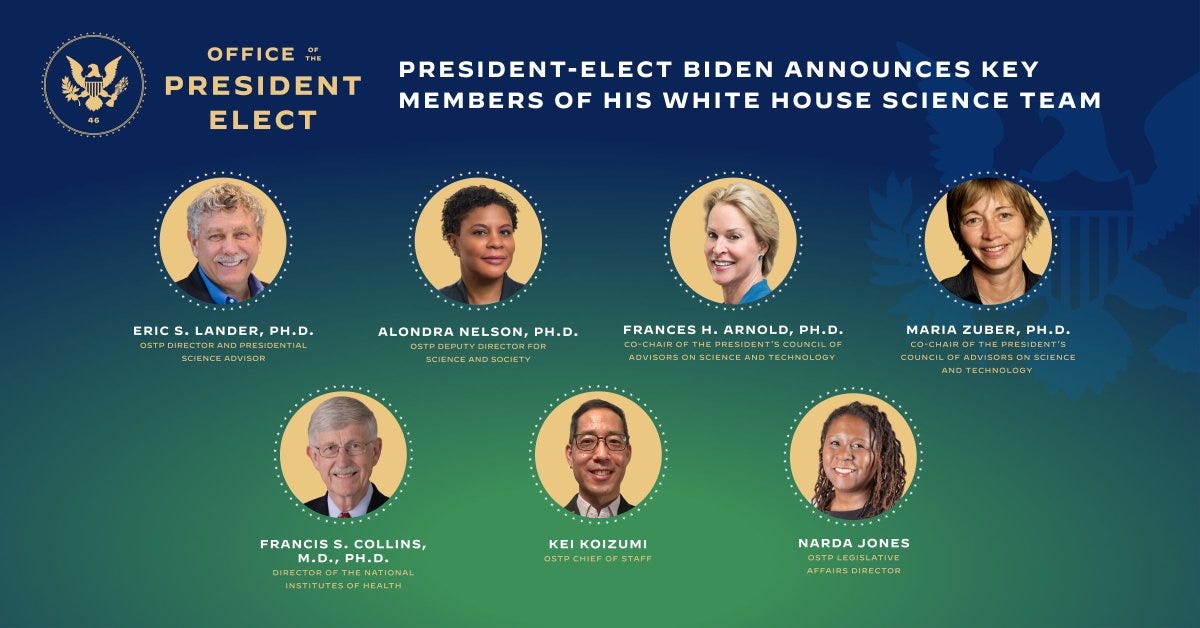Photo: The Honest Broker
The top position held by a scientific leader in any presidential administration is that of the Director of the Office of Science and Technology Policy for the White House. The director is informally known as the Science Advisor to the President. Dr. Alondra Nelson currently holds this position.
As an advisor to the President, Alondra Nelson must be able to provide answers to the following questions - which were sent to her predecessor (and shown below):
1. What can we learn from the pandemic about what is possible—or what ought to be possible— to address the widest range of needs related to our public health?
Even as we work urgently to overcome the coronavirus pandemic, we must learn from this moment by grappling with the challenges, inequities, and opportunities we’ve seen in order to better prepare for the future.
How can we dramatically improve our ability to rapidly address threats from pathogens, including emerging pandemics, potential bioweapons, and antibiotic resistance? How can we dramatically speed our ability to develop and conduct clinical trials of therapies for other types of diseases like cancer? How can we enable the rapid sharing, with patient consent, of health information to build a smarter and more effective healthcare system? How can we use telemedicine to improve health for all Americans?
2. How can breakthroughs in science and technology create powerful new solutions to address climate change—propelling market-driven change, jump-starting economic growth, improving health, and growing jobs, especially in communities that have been left behind?
Climate change represents an existential threat that requires bold and urgent action. But at the same time, the necessity of solving it also presents us with an extraordinary opportunity to make groundbreaking investments in our infrastructure, enhance America’s resilience, promote environmental justice, and create new cutting-edge industries and millions of good-paying jobs that will advance American leadership for generations to come.
Achieving our commitment of net-zero carbon emissions by 2050 will require deploying existing, cost-effective clean energy technologies manufactured in America; drawing on innovative solutions to capture and store carbon; and spurring American technological ingenuity to develop new zero-carbon technologies that can reshape the marketplace. This effort will fortify our economy for the future, create a durable stream of good-paying union jobs in communities across the country, and reassert American leadership on climate change around the globe.
The United States has a long, successful, and bipartisan history of using federal research, purchasing, and policies to help jumpstart critical industries—including, for example, when we pioneered and led the semiconductor industry. How can we refresh that model to deliver a healthier, safer, more prosperous, and sustainable future for our children, while preserving our natural environment for future generations?
3. How can the United States ensure that it is the world leader in the technologies and industries of the future that will be critical to our economic prosperity and national security, especially in competition with China?
From artificial intelligence to synthetic biology, new technologies are emerging in increasingly rapid cycles that promise to transform our lives. Each arrives with a distinct set of promises and challenges—and each carries the capacity to dramatically impact job creation, equity, and national security.
Other countries—especially China—are making unprecedented investments and doing everything in their power to promote the growth of new industries and eclipse America’s scientific and technological leadership. Our future depends on our ability to keep pace with our competitors in the fields that will define the economy of tomorrow.
The right strategy for the United States will necessarily differ from that of our competitors, but it will also likely differ from our own past playbook. What is the right level of national investment, and what are the pillars of a national strategy that will rapidly propel both research and development of critical technologies? What structures, infrastructures, and policies are needed to accelerate the path from research laboratories to development projects to the marketplace? How can we strengthen and expand the connections between academia, industry, and government, which have historically been crucial for advancing technology and protecting national security? And, importantly, how do we ensure that technological advances create rather than diminish high-quality jobs?
4. How can we guarantee that the fruits of science and technology are fully shared across America and among all Americans?
The benefits of science and technology remain unevenly distributed across racial, gender, economic, and geographic lines. How can we ensure that Americans of all backgrounds are drawn into both the creation and the rewards of science and technology? How can we ensure that science and technology hubs flourish in every part of the country, driving economic development in every American hometown? How can we ensure that advances in medical science benefit the health of all Americans, including substantially reducing racial and socioeconomic health disparities?
5. How can we ensure the long-term health of science and technology in our nation?
Science and technology have flourished in the United States because of a rich ecosystem of people, policies, and institutions. This ecosystem must be nurtured and refreshed to succeed in a rapidly changing world.
How can we protect scientific integrity within government—and make government a premier destination for scientists and technologists to work? How can we address stresses on academic research labs and promote creative models for federal research support? How can we reimagine and transform STEM education, empowering teachers and deploying technology to enhance the educational experience? How can we ensure the United States will remain a magnet for the best and brightest minds throughout the world?
There is no better future investment than in science!

No comments:
Post a Comment